As an Amazon Associate I earn from qualifying purchases.
Choosing a surf rod can seem like a daunting task with all the options available today. If you are anything like me you want to get the best bang for your buck. Well it’s not so hard if you just break it down into the individual aspects and focus a small amount of time on each one. I will show you how I used the list below to select a surf rod for myself and I’ll give you a list of quality rods to consider.
The 9 MOST IMPORTANT CONSIDERATIONS when choosing a surf rod are:
- Target Species
- Rod Length
- Spinning vs Conventional
- Graphite vs Fiberglass
- Action
- Power
- One Piece or Two Piece
- Price Points
- Reputation (Reviews)
1. Target Species
The first thing you will want to consider is what species you will be targeting. If you don’t have a particular species in mind that’s not really a problem, but you should know that there can be a bit of variance in what’s ideal for something like pompano vs medium sized sharks. When I carry more than one rod to the beach, I personally always take one that can handle larger fish. You, however, may not need a “big fish” rod if you are only after smaller tasty fish such as Pompano, Redfish, Whiting or Flounder. So, when choosing a surf rod, first try to decide if you want a general purpose rod or one more specialized to a certain sized fish.
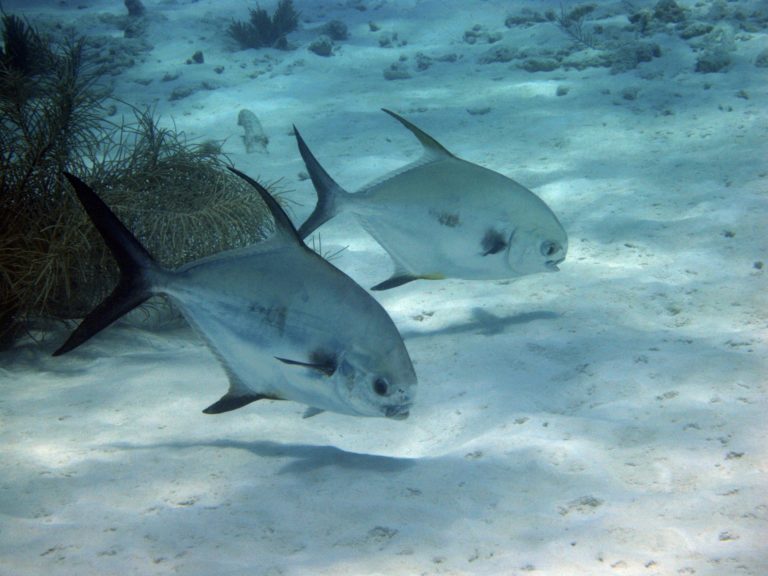
2. Rod Length
After deciding what you want to catch, that will help lead you to what length rod you need. My focus here will be on rods over eight feet as that is what I consider the minimum length for fishing from the beach.
The length is not only for casting distance but also to keep your line out of the surf.. If your line is hanging in the crashing waves, the surf will pull your bait away from where you put it. This also creates slack in the line making it impossible to detect bites. A long rod also keeps your line well above passing tourists. You want people to be able to easily walk under your line. Most folks will walk behind your setup, but depending on where you fish, you will have beach goers walk between your rod and the surf.
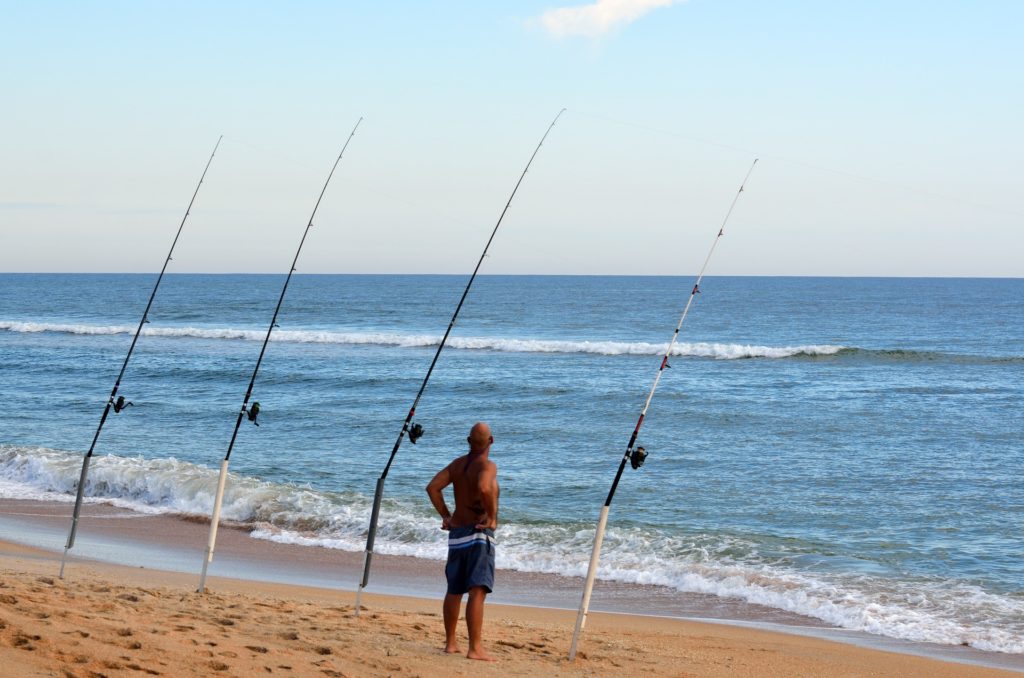
If you plan on holding the rod a lot because maybe you are fishing with lures, I would lean more toward an 8 to 10 foot rod. You will appreciate the lighter weight. Otherwise, go with a longer rod that is 11-13 feet to get more distance on your casts. A good general purpose length is 10 feet.
For targeting fish such as pompano, redfish, sharks and whiting I prefer to put my rod in a rod holder. In those cases I always lean toward a longer pole. However, if you will be casting for bluefish, stripers, spanish mackerel or flounder you will probably want to stay with a rod that is 8-10 feet.
One trade off you do have with longer rods is LESS leverage when fighting larger fish. So, when targeting fish such as medium-sized sharks I wouldn’t go much over 11 feet or you are giving up a big advantage to the fish.
Don’t misunderstand that you should always be using your long rod to heave out as far as you can. Depending on your area, there are many fish (and not just small ones) right up next to the beach. This is particularly true in the early morning and late evening. Put the bait where the fish are and you WILL catch fish. If that’s 10 feet off the beach, then that’s where you should cast.
Shorter Rods (8-10 feet)
- Lighter
- More Accurate Casting
- Better for Casting Lures
- More Leverage on Big Fish
- Shorter Casting Distance
Longer Rods (11-14 feet)
- Increased Casting Distance
- Keeps Line out of Surf
- Keeps Line Above Passing Tourists
- Heavier
- Less Leverage on Big Fish
3. Spinning vs Conventional
When choosing a surf rod, the decision between spinning vs conventional rods is really a choice between spinning vs conventional REELS. I view this as mostly a personal preference. You should go with whatever reel style you prefer.
There are strong arguments as to why both could be considered better than the other. It used to be that you had to use conventional reels to get a strong drag. But, spinning reels have come a long way and have closed the gap when it comes to drag performance and strength as compared to conventional reels. So, even for larger fish, a spinning outfit is still a great option.
If in doubt, go with a spinning outfit as there is not as much of a learning curve.
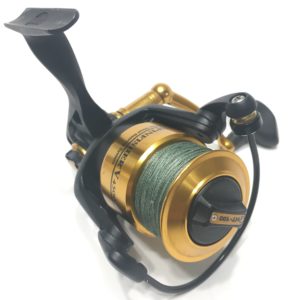
Following are some of the advantages and disadvantages of conventional vs spinning setups.
Conventional Setup
- Stronger Top-End Drag
- Further Casting Distance with Proper Skills
- Great for Casting Heavy Weights
- Backlashes
Spinning Setup
- No Backlashes
- Better for Fishing at Night (no backlashes)
- Line Twist
- Braided lines can cut your finger when trying to cast really heavy weight (6+ ounces)
Note: Line Twist can be minimized by not reeling against the drag when fighting a fish. When the fish is running let him run. You also need to make sure the line is spooled properly and that you flip the bail manually after each cast.
When it’s all said and done, I prefer spinning tackle for the beach due to simplicity and ease of use.
4. Graphite vs Fiberglass vs Composite
You will need to decide if you prefer graphite or fiberglass and there are great rods available in both. You may also run across the term “carbon fiber” when rod shopping. Don’t let that confuse you. Carbon Fiber and Graphite rods are pretty much the same thing. There are also some composite rods that contain both fiberglass and graphite, which as you might imagine, combines some of the strengths of each.
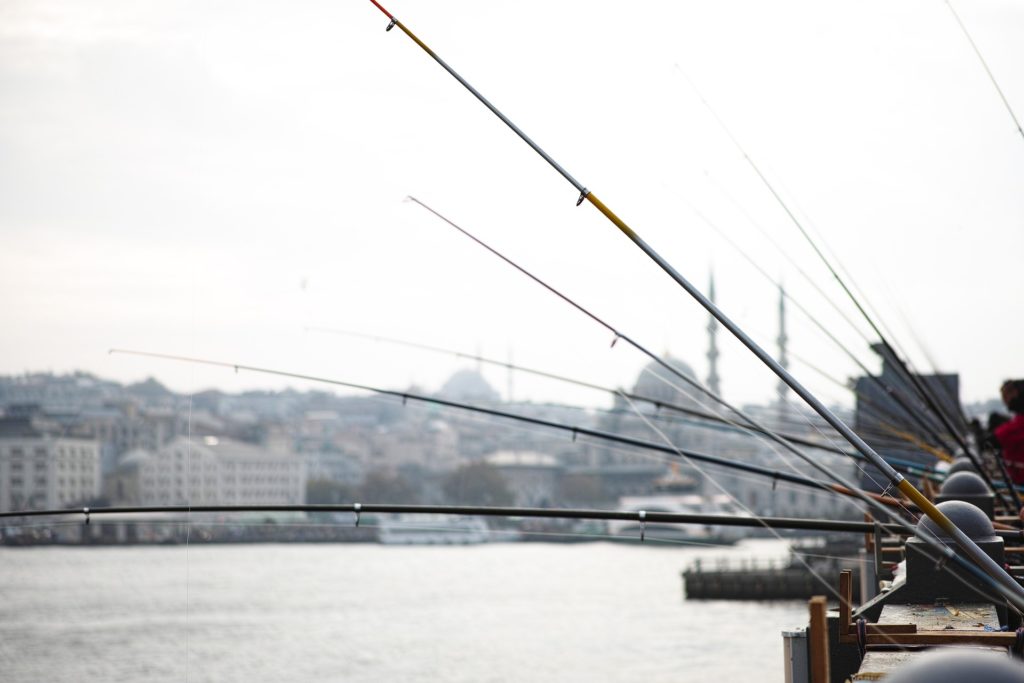
Some advantages of a fiberglass rod are that they are cheaper, stronger and more durable than graphite rods. A couple disadvantages are that they are heavier and less sensitive than graphite rods.
Since graphite rods are more sensitive, they allow detection of more subtle pickups. Graphite rods are also faster (see more about this under the #5 “Action” below).
If you will be casting out bait on a circle hook and sticking your rod in a rod holder, then a fiberglass rod is a great option. It will save you some money if you don’t need the sensitivity and powerful hook-sets of a graphite rod.
When you start shopping for a rod you will find there are many more graphite options than fiberglass. I found it difficult to actually get away from graphite rods out in the marketplace. But you can definitely find some good fiberglass options if you look hard. There is just a more limited selection.
Fiberglass Rods
- Cheaper
- Stronger
- More Durable
- Heavier
- Less Sensitive
Graphite Rods
- More Sensitive
- Faster (makes for more powerful hooksets)
- Better Selection
- Lighter
- More Expensive
5. Action (or Speed)
Your next choice will be what action you prefer. The action of a rod refers to where the rod bends when pressure is applied to the tip. Action is also referred to as the speed of a rod. The common categories are slow, medium and fast. Refer to my rather bad sketch below to better understand what that means.
A faster rod bends in the top one fourth to one third of the rod blank, whereas a slower rod bends further down toward the handle. You can see this when you place the rod tip on the ground and push down while holding the butt of the rod. You can, and should, do this inside the store just don’t advertise it too much. They might not like that.
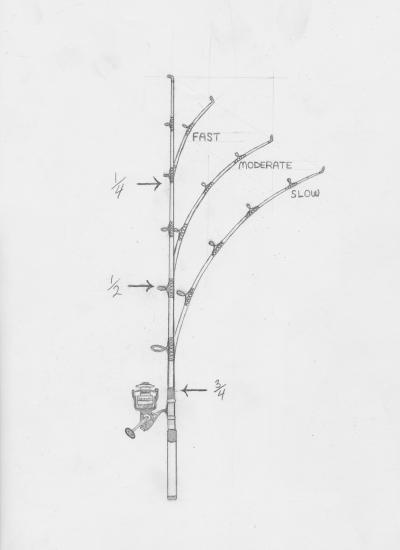
Advantages and Disadvantages of Different Rod Actions
Faster action rods are more accurate when casting and provide better sensitivity. They also provide more solid hook-sets by quickly transferring the energy of the rod to the fish. This is because the rod loads up faster since only the tip flexes. A faster action rod also gives you a better ability to turn a big fish. So, there are lots of advantages to a faster action rod.
Medium and Slower action rods allow you to load the rod up during a cast and provide for better casting distance. They are also better for keeping a fish hooked up as the rod has more give. This helps prevent ripping or bending the hook during a fight. Medium and Slower action rods excel when tossing live bait as there is less chance of slinging the bait off during the cast. Since faster action rods require more force to properly load up on the cast, the extra force can sling the bait off.
If you usually use circle hooks and stick your rod is in a rod holder, which is generally what I do, then medium action rods are a great choice. In this scenario rod sensitivity and casting accuracy is not nearly as important. You also don’t need powerful hook-sets since the fish will usually set the hook himself with a circle hook.
If, however, you will be holding the rod to feel the bite or if you are going after larger fish then fast action rods might be a better fit.
Faster Rods
- More Accurate
- Better Sensitivity
- More Solid Hooksets
- Better Ability to Turn Big Fish
- Ideal for Soft Bites Such as Flounder and Trout
Slower Rods
- Better Casting Distance
- Better at Keeping a Fish Hooked Up During the Fight
- They Excel at Tossing Live Baits Without Slinging Off
6. Power
Power, or the strength of the rod, will be one of the most important considerations you need to take into account when choosing a surf rod. It is also sometimes called the weight of the rod and it refers to how much pressure or weight it takes to induce the rod’s action.
A heavy power rod takes a heavier amount of weight or pressure to bend the blank.
Conversely, a light power rod requires less pressure to bend the rod. Generally power is broken down into Light, Medium, Medium-Heavy, Heavy and Extra-Heavy. Medium or Medium-Heavy are excellent overall choices if you aren’t targeting any particular species.

More powerful rods will handle more powerful fish so you might prefer a Heavier action rod for things like Bull Reds, Sharks, Tarpon, etc. Conversely, you will want to lean towards a Medium power rod for smaller species such as Pompano, Flounder (Fluke), Whiting, Trout or slot Reds. I never use Light power rods when surf fishing as they are just not up to the task of surf fishing.
You do get better sensitivity out of a Medium power rod which helps in some of the same situations as a fast action does. They would perform better for fish where the bite is lighter such as flounder and trout. Obviously the need for sensitivity diminishes the larger the fish you are targeting. When a 5 foot bull shark picks up your bait you are going to know it and at that point you will much prefer to have the heavy power rod in your hand.
The rods power rating also ties to what size lures and weights you can efficiently cast with the rod. The acceptable lure rating will be listed on the rod blank and should be taken into consideration when choosing a surf rod. Even though a Medium rod might work for larger fish, you wouldn’t want to buy a Medium rod if you need to cast 6 ounces (that’s a lot) of weight for example.
Below is just a rough guideline to give you a general idea of what strength rod is most beneficial for what species. It should be noted that some of how you choose your rod’s power is based on personal preference. A heavier power rod is going to allow you to get a fish to shore quicker and thus improve it’s survival rate. But, a Medium rod will work just fine in most cases while providing you a more sporting fight.
Medium
- Speckled Trout
- Slot Redfish
- Flounder (Fluke)
- Pompano
- Whiting
Medium-Heavy
- Bull Redifsh
- Bluefish
- Stripers
- Handles most Sizes of Fish Well
- Great General Purpose Rod
Heavy
- Medium Sharks
- Large Tarpon
- Large King Mackerel
There is also a related line rating listed on most rods that corresponds to the rod’s power rating. I generally try to match my line strength to those ratings but it seems most people don’t find this to be too critical and they commonly go way beyond the max line rating, especially when using braid. Just keep in mind that you do run a higher risk of breaking your rod if you use line rated far greater than the max range of the rod. Also, if you use a line too light you will likely have break-offs.
Note: Some rod manufacturers void their warranty if you use line outside the recommended range.
7. One Piece vs Two (or more) Pieces

The obvious huge benefits of two piece rods are that they are great for compact storage and the ability to fit them into automobiles. This is particularly useful when it comes to long surf rods.
I prefer 2 piece rods for anything over 8’. So that means I always buy 2 piece surf rods as I don’t buy rods less than 8 feet for beach fishing. You may have a different preference.
I think modern 2 piece rods are, for all practical purposes, every bit as strong as one piece rods. And, I have never broken a rod because it was 2 piece. I have however broken rods during transport because of the cumbersomeness involved with excessive length.
To be clear, I think most people would prefer one piece rods when storage and transportation are not factors. But those two things quite often cannot be ignored.
It seems the biggest concern with modern 2 piece rods is that they might separate during a cast. But, if you use the proper method of locking the two pieces together you should have no problems.
When you assemble the rod, you need to lock the pieces together properly before use. Don’t just shove the pieces together with the eyelets lined up. Instead, ensure the connecting parts are clean and dry, then hold the top portion at about 45 degrees from the bottom and slide them together all the way but not too tight. Then, twist them into alignment while applying gentle force. This should solidly lock the rod together. Just twist the rod while pulling to take it back apart.
A word of caution – be sure you do not have moisture inside the rod when you connect the pieces as you could create a vapor lock. This can make it very difficult to separate the halves. If you do ever get your rod stuck together, use something rubberized like a jar opener to grip the rod firmly to twist apart. DO NOT grab the guides for leverage!
8. Price Points
You can buy a surf rod for as little as $30 and they go all the way up to $700 and beyond. The selections in the lower price points are generally going to be constructed of fiberglass and there are some good rods in those lower price ranges if you are OK with fiberglass. Just determine how much you want to spend and go from there.
Typically one of the things you get with a higher price point are nicer components. You might get a nicer cork handle but there is absolutely nothing wrong with a foam handle. That is primarily just a personal preference. You also tend to get nicer guides and a better reel seat in a higher end rod. Fuji is an example of very high quality, long lasting components found on higher end rods.
There is no shame in carrying a $30 fiberglass rod to the beach. There are some great fiberglass rods under $100 that will get the job done. The Daiwa Beefstick and Shakespeare Ugly Stick come to mind.
As far as graphite rods, you can spend however much you want. But, I think you can get a GREAT rod in the $130-$300 range.
One thing to note is that generally the shorter a graphite rod gets the cheaper it gets. So if you are trying to save a few bucks a 9 or 10 foot graphite rod is a good option.
9. Reviews and Reputation

No matter how well a rod seems to match the specs you want, I strongly recommend you search out real world reviews on the particular rods you are considering. Even quality brands can produce a dud.
Amazon.com is the obvious first choice to hit up for reviews, but I wouldn’t stop there. If the number of reviews is too low, you can get a misconception of a rod. Just do a web search on the specific rod you are considering and you should be able to find plenty of info if it’s an established model (i.e. Tica Dolphin, Shakespeare Ugly Stick, Tsunami Airwave, Lamiglas GSB, etc) . If it’s not an established model, I would steer away and let someone else be the guinea pig.
Visit these sites for quality reviews.
- Amazon.com
- TackleDirect.com
- Walmart.com
- Cabelas.com
- Basspro.com
- General Google Searches
- StripersOnline.com (forum)
- Other Assorted Fishing Forums
Conclusion
Hopefully this list helps you zero in on what best suits your needs when choosing a surf rod. If still in doubt, it would be hard to go wrong with a 10 foot medium-heavy graphite rod that can handle 20 pound mono. Find one from a reputable brand name manufacturer with good reviews at the price you want and go fishing!
Following is how I used the list above to make my own buying decision
I ultimately decided to go with the Tica Dolphin Extra Heavy surf rod.
Specifically, it’s the Tica UGSA12XH2S, which has the following specs: Extra Heavy, 12 feet, 2 piece, 20-50lb line, Fast Action, 6-12 oz bait range
I had narrowed my choice down between the Penn Carnage II and the Tica Dolphin Extra Heavy, and I decided to go with a Tica Dolphin for the following reasons.
1. Species
The species I intend to target with this particular rod were Bull Reds and medium-sized sharks, so I knew I wanted a heavy to extra-heavy power spinning rod.
2. Rod Length
I needed a longer rod to get my bait out away from the beach. My 9 Ugly Stick wasn’t long enough to cast my long shark leaders as far as I wanted. So, I decided to go with a 12 foot rod to remedy that.
3. Spinning vs Casting
Since I’m always dealing with wind on the beach and since I wanted to target these critters sometimes at night I decided on a spinning rod. I also already had a Penn Spheros 18000 to pair with it.
4. Graphite vs Fiberglass vs Composite
I decided to go with graphite partly because there seem to be more proven graphite rods in the marketplace. Also, since I wanted a 12 foot rod, graphite cuts down on the weight.
5. 1 Piece vs 2 (or more) Pieces
Because I knew I would oftentimes be transporting the rod in my vehicles, I went with a 2 piece rod. As already stated, I think 2 piece rods perform great and there was zero temptation for me to buy a 1 piece 12 foot rod.
6. Action
Since there were so many advantages of a fast action rod, including the ability to turn a big fish, that is what I decided to go with.
7. Power
The Tica Dolphin Extra Heavy is supposedly comparable to the old BassPro Ocean Master Rods. Those Ocean Masters were powerful heavers, great at casting heavy baits, and they got great reviews for my intended use. Sadly, those rods seem to have been discontinued. The Dolphin is rated to throw 6-12 ounces so it more than met the minimum I needed.
8. Price Points
I initially didn’t feel like I had a rigid price range. But the more I pondered, the more I couldn’t see spending over $300 on a rod I was going to stick in a rod holder. So I guess I sort of had my upper limit ultimately falling around $250. And since I’m budget-minded, I ended up spending even less than that. With this price point i was still able to get high quality Fuji components.
9. Reviews and Reputation
The Tica Dolphin has a very strong reputation. The Amazon reviews are great and I found positive opinions of it in multiple other locations on the web.
Note: The Dolphin also had one less guide and the guides are larger than on the Penn Carnage. This was of importance to me because I intended to sometimes tie a long mono leader to my mainline braid. I needed my FG Knot to pass freely through the guides during a cast. This was also a deciding factor between the Dolphin and the Penn Carnage. So, if I had to add a number “10” then you might want to consider the rod’s components and the layout of them on the rod.
So, that’s it. That is how I came to the decision on what rod best suited me.
Some Other Rods I Considered Buying
Following are some other great rods I would consider if I were in your shoes:
Penn Carnage II – I almost purchased this rod. The deciding factors between this one and the Tica Dolphin were the number and size of the guides and the slightly lower price of the Tica. The Dolphin also seemed to have a longer, more proven track record.
St. Croix Mojo Surf – These are nice rods. I just didn’t feel like their reputation outweighed the Tica for my specific purposes. If we were talking about something other than a sharking rod it would be a different story.
Penn Prevail Surf Spinning Rod – I actually own one of these rods and like it a lot. A friend of mine also just bought one for himself, and he did his research independently of my own. If your budget is tight, give this one a close look. I just wanted to try something different and a little more proven for my bigger rod this time.
Penn Battalion – these seem to be solid rods but they were not rated for as high of a lure weight as I needed for my application. This could be a great option for you and I will consider it for future applications.
Ugly Stick: – I think these are one of the best cheap options out there and I have no complaints with the 9 footer I own. I just decided to spring for a longer graphite rod this time. I don’t think you could go wrong with one of these if you are looking for a rod to soak bait.
Lamiglas GSB “old school” rod – These seemed as though they would be a nice fit for my application but they were out of my price range. You can pick one of these up on Tackledirect.com for a little over $400. They have a strong reputation on the forums. So, if you can handle the price tag, these are a great option.
Daiwa Tournament Ballistic rod – This is another very nice rod, but again out of my price range. Worth looking into if you have a high budget.
Tsunami Airwave – The Airwave is a very nice rod. This one just didn’t have a high enough lure weight rating for my particular use. I’ll definitely consider this one for future applications.
Okuma Surf Rods – I considered several Okuma brand surf rods. This is a brand that makes nice affordable rods. Just search Amazon for “Okuma Surf Rod”. This seems like a good affordable fiberglass option – TXP-S-1202MH.
Good luck in finding a great surf fishing rod that suits YOU!
Augustus Clay
After you decide on the right surf rod for you, maybe you would be interested in learning how to use it to target pompano, whiting or Spanish mackerel. If so, I have comprehensive articles on how to do just that. How To Catch Pompano, How To Catch Whiting, and How To Catch Spanish Mackerel.




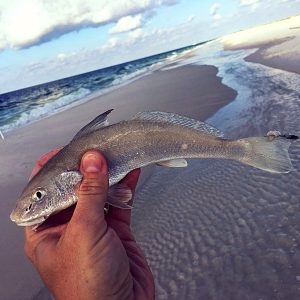
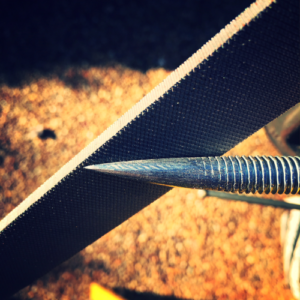
Augustus
6 Aug 2018This is my very first blog post ever! I hope you found it to be helpful.
Gus